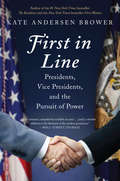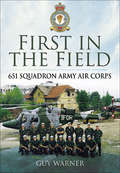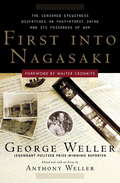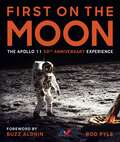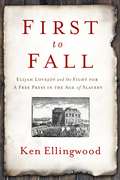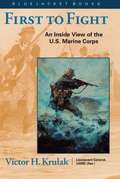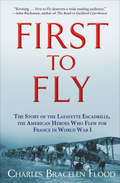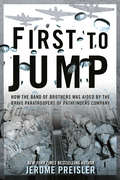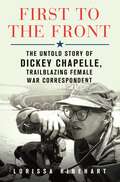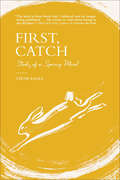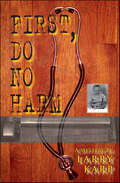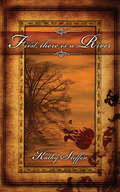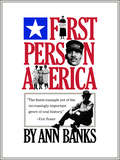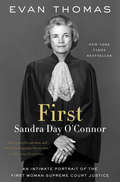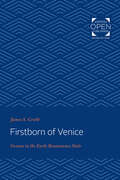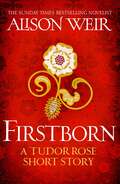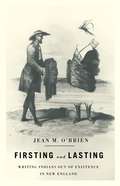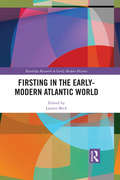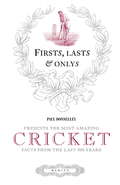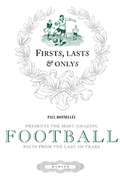- Table View
- List View
First in Line: Presidents, Vice Presidents, and the Pursuit of Power
by Kate Andersen BrowerFrom the author of the New York Times bestsellers First Women and The Residence, an intimate, news-making look at the men who are next in line to the most powerful office in the world—the vice presidents of the modern era—from Richard Nixon to Joe Biden to Mike Pence.Vice presidents occupy a unique and important position, living partway in the spotlight and part in the wings. Of the forty-eight vice presidents who have served the United States, fourteen have become president; eight of these have risen to the Oval Office because of a president’s death or assassination, and one became president after his boss’s resignation. John Nance Garner, FDR’s first vice president, famously said the vice presidency is "not worth a bucket of warm piss" (later cleaned up to "warm spit"). But things have changed dramatically in recent years. In interviews with more than two hundred people, including former vice presidents, their family members, and insiders and confidants of every president since Jimmy Carter, Kate Andersen Brower pulls back the curtain and reveals the sometimes cold, sometimes close, and always complicated relationship between our modern presidents and their vice presidents.Brower took us inside the lives of the White House staff and gave us an intimate look at the modern First Ladies; now, in her signature style, she introduces us to the second most powerful men in the world, exploring the lives and roles of thirteen modern vice presidents—eight Republicans and five Democrats. And she shares surprising revelations about the relationship between former Vice President Joe Biden and former President Barack Obama and how Vice President Mike Pence and President Donald Trump interact behind closed doors.From rivals to coworkers, there is a very tangible sense of admiration mixed with jealousy and resentment in nearly all these relationships between the number two and his boss, even the best ones, Brower reveals. Vice presidents owe their position to the president, a connection that affects not only how they are perceived but also their possible future as a presidential candidate—which is tied, for better or worse, to the president they serve. George H. W. Bush and Ronald Reagan had a famously prickly relationship during the 1980 primary, yet Bush would not have been elected president in 1988 without Reagan’s high approval rating. Al Gore’s 2000 loss, meanwhile, could be attributed to the Monica Lewinsky sex scandal and Bill Clinton’s impeachment. Current Vice President Mike Pence is walking a high-stakes political tightrope as he tries to reassure anxious Republicans while staying on his boss’s good side.This rich dynamic between the president and the vice president has never been fully explored or understood. Compelling and deeply reported, grounded in history and politics, and full of previously untold and incredibly personal stories, First In Line pierces the veil of secrecy enveloping this historic political office to offer us a candid portrait of what it’s truly like to be a heartbeat away.
First in Thirst: How Gatorade Turned the Science of Sweat Into a Cultural Phenomenon
by Darren Rovell*Selected as one of Soundview Executive Book Summaries's the "30 Best Business Books" of the year.* Remember the Cola Wars, with Coke and Pepsi battling it out year after year for supremacy in the soft drink market? Or what about the Burger Wars, the legendary slugfests between McDonald's and Burger King? Then of course, there were the Sports Drink Wars. If you blinked, you might have missed them, because Gatorade has swiftly and decisively fended off every would-be rival. Although a few other brands hold slim market shares, the fact is that Gatorade single-handedly created the sports drink industry 40 years ago and has absolutely ruled it ever since. But Gatorade is more than just a triumph of branding. First, it's a trusted product that has been scientifically proven to do what it claims to do. Second, Gatorade is an enthralling story, brought to life in bright color and sharp detail in First in Thirst. Author Darren Rovell, a skilled, objective, and passionate journalist, chronicles every astonishing milestone of the company's history. With unprecedented access to the inventors, the marketers, the analysts and observers, and key company figures past and present, Rovell recounts the sweat-drenched University of Florida football practices, the first (unpalatable) prototypes, and the commercial and financial interest that quickly took hold following the drink's first on-field successes. Then came the advertising, sponsorships, product placements (many of them fortuitous), and finally the two milestones that cemented Gatorade's iconic status once and for all -- the ubiquitous Gatorade bath and the Michael Jordan ""Be Like Mike"" endorsement deal. With refreshing candor, First in Thirst also offers an inside look at the negotiations, battles, lawsuits, mergers and acquisitions, product strategies, lucky breaks, and even the missteps (there have not been many) that have attended Gatorade's reign as the 800-pound gorilla of the sports-drink scene. Rovell places the reader inside labs and brainstorming sessions, at board meetings and ad shoots, on the sidelines and in the dugouts, even in the winner's circle at NASCAR events -- where Gatorade manages maximum exposure even at tracks whose official sponsors include chief rival POWERade. The book identifies the nine Gatorade Rules, business principles that have helped Gatorade become one of the most dominant brands ever. By adhering to these principles, businesses in other industries may achieve greater brand recognition and market share. Long before America knew what ""deep-down body thirst"" was, a team of university scientists had already invented something to quench it. First in Thirst is the story of the product and the company, and of America's fascination with the one and only Gatorade.
First in War: George Washington in the American Revolution
by John RosenburgThis book chronicles George Washington's role in the American Revolution, from his appointment as commander in chief of the Continental Army to the British surrender at Yorktown and his famous farewell address.
First in the Field: 651 Squadron Army Air Corps
by Guy Warner651 was the first Air Observation Post (AOP) Squadron, formed at Old Sarum on August 1 1941 to work closely with army units in artillery spotting and liaison. It was still part of the RAF but all the pilots, drivers and signalers were from the Royal Artillery, while the RAF supplied the Adjutant, Engineer Officer and technicians. It is therefore the premier Army Air Corps squadron. Its first aircraft were an assortment of Taylorcraft Plus Cs and Ds, three Piper Cubs and a Stinson Voyager. Then later that year all 651s aircraft were replaced by the version of the Plus D manufactured by Taylorcraft in Britain and renamed the Auster I. These were deployed on active service in November 1942, to Algeria and then Tunisia, as part of Operation Torch. Its main duties were the direction of artillery fire, reconnaissance and light liaison. By May 1943 Tunisia was under Allied control and 651 moved to Sicily in support of offensive operations by 8th Army in August. Now equipped with Auster IIIs and flying by night and day, support was given to XIII Corps on the coast of the island, registering targets and directing counter-battery fire, including that of Royal Naval warships. On September 4, it became the first AOP unit to cross the Straits of Messina to participate in the invasion of Italy, again with 8th Army. In May 1944, the Squadron flew in support of 2nd Polish Corps during the capture of Monte Cassino, a major obstacle in the advance of Allied forces on Rome. Throughout the remainder of the war the Auster IVs and Vs of 651 Squadron worked with almost every division in Italy as they came in and out of the front line. Over the years that followed, 651 Squadron served in Austria, Palestine on internal security duties (where a landing was made on the aircraft carrier HMS Ocean in 1947), Eritrea protecting Italian civilians from Shifta bandits, Libya, Iraq during the Persian Oil Dispute, Egypt patrolling the Canal Zone and Cyprus, where in August 1953 HQ and 1910 Flights were the first AOP assets to deploy there. Further marks of Auster were introduced, AOP 6s, 9s and T.7sIn 2000 it was selected as the Attack Helicopter Fielding Squadron to bring the Westland Apache AH.1 into service, in which role it served very successfully for the next three years at Middle Wallop. Then in 2004 it was all change again with a move to RAF Odiham to operate the Defender AL.1 in the ISTAR (Intelligence, Surveillance, Target Acquisition, and Reconnaissance) support role as part of the Joint Special Forces Aviation Wing. Since that time it has been continuously engaged in operations.
First in the Homes of His Countrymen: George Washington's Mount Vernon in the American Imagination
by Lydia Mattice BrandtOver the past two hundred years, Americans have reproduced George Washington's Mount Vernon plantation house more often, and in a greater variety of media, than any of their country's other historic buildings. In this highly original new book, Lydia Mattice Brandt chronicles America's obsession with the first president's iconic home through advertising, prints, paintings, popular literature, and the full-scale replication of its architecture.Even before Washington's death in 1799, his house was an important symbol for the new nation. His countrymen used it to idealize the past as well as to evoke contemporary--and even divisive--political and social ideals. In the wake of the mid-nineteenth century's revival craze, Mount Vernon became an obvious choice for architects and patrons looking to reference the past through buildings in residential neighborhoods, at world's fairs, and along the commercial strip. The singularity of the building's trademark piazza and its connection to Washington made it immediately recognizable and easy to replicate. As a myriad of Americans imitated the building's architecture, the Mount Vernon Ladies' Association carefully interpreted and preserved its fabric. Purchasing the house in 1859 amid intense scrutiny, the organization safeguarded Washington's home and ensured its accessibility as the nation's leading historic house museum. Tension between popular images of Mount Vernon and the organization's "official" narrative for the house over the past 150 years demonstrates the close and ever-shifting relationship between historic preservation and popular architecture.In existence for roughly as long as the United States itself, Mount Vernon's image has remained strikingly relevant to many competing conceptions of our country's historical and architectural identity.
First into Nagasakii: The Censored Eyewitness Dispatches on Post-atomic Japan and Its Prisoners of War
by George WellerIn was on 6 September 1945 that American journalist Weller (1907-2002) entered the Japanese city that had received an American atomic bomb on 9 August. His dispatches--sometimes several a day--were censored and destroyed by US General MacArthur. Weller salvaged his carbon copies, but they were lost as he traveled around the globe. His son Arthur, novelist and musician, recently discovered them, and publishes them here. They are not indexed. Annotation ©2007 Book News, Inc. , Portland, OR (booknews. com)
First on the Moon: The Apollo 11 50th Anniversary Experience
by Rod PyleIn honor of the 50th anniversary of the groundbreaking Apollo 11 mission, this lavishly illustrated book—featuring stunning photographs and many rarely seen images and documents—tells the incredible story of the first men on the Moon. Acclaimed science author Rod Pyle (Missions to the Moon) returns with a beautiful and insightful book commemorating Apollo 11. First on the Moon offers an exciting behind-the-scenes look at America&’s journey to the Moon—from the space race to the landing on the Sea of Tranquility to splashdown on Earth and the aftermath. Pyle spent years combing NASA archives and private collections for memorabilia from the mission, and the book includes everything from accessible explanations of the enormous challenges facing NASA to reproductions of original 1969 documents. It also features a number of specially commissioned photocompositions created from NASA Apollo images released in 2015. Many were parts of photomontages taken by the astronauts, and these compositions have now been carefully restored to their originally intended montage formats. With compelling firsthand accounts and a gripping narrative, this gorgeously designed volume fully immerses readers in the Space Age. Includes a foreword by Buzz Aldrin, and exclusive interviews with the adult children of the Apollo 11 astronauts.
First to Fall: Elijah Lovejoy and the Fight for a Free Press in the Age of Slavery
by Ken EllingwoodA vividly told tale of a forgotten American hero—an impassioned newsman who fought for the right to speak out against slavery. The history of the fight for free press has never been more vital in our own time, when journalists are targeted as &“enemies of the people.&” In this bnrilliant and rigorously researched history, award-winning journalist and author Ken Ellingwood animates the life and times of abolitionist newspaper editor Elijah Lovejoy. First to Fall illuminates this flawed yet heroic figure who made the ultimate sacrifice while fighting for free press rights in a time when the First Amendment offered little protection for those who dared to critique America&’s &“peculiar institution.&” Culminating in Lovejoy&’s dramatic clashes with the pro-slavery mob in Alton, Illinois—who were torching printing press after printing press—First to Fall will bring Lovejoy, his supporters and his enemies to life during the raucous 1830s at the edge of slave country. It was a bloody period of innovation, conflict, violent politics, and painful soul-searching over pivotal issues of morality and justice. In the tradition of books like The Arc of Justice, First to Fall elevates a compelling, socially urgent narrative that has never received the attention it deserves. The book will aim to do no less than rescue Lovejoy from the footnotes of history and restore him as a martyr whose death was not only a catalyst for widespread abolitionist action, but also inaugurated the movement toward the free press protections we cherish so dearly today.
First to Fight
by Victor H. KrulakMarine general Victor "Brute" Krulak offers here a riveting insiders's chronicle of U.S. Marines - their fights on the battlefield and off, and their extraordinary esprit de corps. He not only takes a close look at the Marine experience during World War II, Korea, and Vietnam - wars in which Krulak was himself a participant - but also examines the foundation on which the Corps is built. In doing so, he helps answer the question of what it means to be a Marine and how the Corps has maintained such a consistently outstanding reputation.
First to Fly: The Story of the Lafayette Escadrille, the American Heroes Who Flew for France in World War I
by Charles Bracelen FloodIf the Wright brothers’ 1903 flights in Kitty Hawk marked the birth of aviation, World War I can be called its violent adolescence-a brief but bloody era that completely changed the way planes were designed, fabricated, and flown. The war forged an industry that would redefine transportation and warfare for future generations. In First to Fly, lauded historian Charles Bracelen Flood tells the story of the men who were at the forefront of that revolution: the daredevil Americans of the Lafayette Escadrille, who flew in French planes, wore French uniforms, and showed the world an American brand of heroism before the United States entered the Great War.As citizens of a neutral nation from 1914 to early 1917, Americans were prohibited from serving in a foreign army, but many brave young souls soon made their way into European battle zones: as ambulance drivers, nurses, and more dangerously, as soldiers in the French Foreign Legion. It was partly from the ranks of the latter group, and with the sponsorship of an expat American surgeon and a Vanderbilt, that the Lafayette Escadrille was formed in 1916 as the first and only all-American squadron in the French Air Service. Flying rudimentary planes, against one-in-three odds of being killed, these fearless young men gathered reconnaissance and shot down enemy aircraft, participated in the Battle of Verdun and faced off with the Red Baron, dueling across the war-torn skies like modern knights on horseback.Drawing on rarely seen primary sources, Flood chronicles the startling success of that intrepid band, and gives a compelling look at the rise of aviation and a new era of warfare.
First to Jump
by Jerome PreislerThe U.S. Army Pathfinders. The vanguard of the Allied forces in World War II Europe. Countless times they preceded invasions and battles vital to bringing the enemy to its knees. Because before the front lines could move forward, the Pathfinders had to move behind enemy lines . . . The first into combat, and the last out, their advance jumps into enemy territory were considered suicide missions by those who sent them into action. World War Two's special operations commandos, they relied on their stealth, expert prowess, and matchless courage and audacity to set the stage for airborne drops and glider landings throughout Europe. They were born of hard necessity. After the invasion of Sicily almost ended in disaster, General Jim Gavin was determined to form an all-new unit of specialized soldiers who would jump ahead of the airborne forces--including the now legendary Easy Company--without any additional support, stealing across enemy terrain to scout and mark out drop zones with a unique array of homing equipment. Sporting Mohawk haircuts, war paint, and an attitude of brash confidence, they were the best of the best. Their heroic feats behind the lines were critical to nearly all of the Allies' major victories from Normandy to snowy Bastogne--where they saved the day for thousands of besieged American troops in an operation almost forgotten by history--to the attack on the Ruhr River in Germany. This is the story of the U.S. Army Pathfinders--their training, bonding, and battlefield exploits--told from the perspectives of the daring men who jumped and the equally bold transport crews who risked everything to fly them into action. INCLUDES PHOTOS
First to the Front: The Untold Story of Dickey Chapelle, Trailblazing Female War Correspondent
by Lorissa RinehartThe first authoritative biography of pioneering photojournalist Dickey Chapelle, who from World War II through the early days of Vietnam got her story by any means necessary as one of the first female war correspondents."I side with prisoners against guards, enlisted men against officers, weakness against power."From the beginning of World War II through the early days of Vietnam, groundbreaking female photojournalist and war correspondent Dickey Chapelle chased dangerous assignments her male colleagues wouldn’t touch, pioneering a radical style of reporting that focused on the humanity of the oppressed. She documented conditions across Eastern Europe in the wake of the Second World War. She marched down the Ho Chi Minh Trail with the South Vietnamese Army and across the Sierra Maestra Mountains with Castro. She was the first reporter accredited with the Algerian National Liberation Front, and survived torture in a communist Hungarian prison. She dove out of planes, faked her own kidnapping, and endured the mockery of male associates, before ultimately dying on assignment in Vietnam with the Marines in 1965, the first American female journalist killed while covering combat.Chapelle overcame discrimination both on the battlefield and at home, with much of her work ultimately buried from the public eye—until now. In First to the Front, Lorissa Rinehart uncovers the incredible life and unparalleled achievements of this true pioneer, and the mark she would make on history.
First, Catch: Study of a Spring Meal
by Thom Eagle“Eagle, a chef and food writer, uses a nine-dish lunch as the occasion to ruminate about cooking, and life” (New York Times Book Review).First, Catch is a cookbook without recipes, an invitation to journey through the digressive mind of a chef at work, and a hymn to a singular nine-dish festive spring lunch. In Eagle’s kitchen, open shelves reveal colorful jars of vegetables pickling over the course of months, and a soffritto of onions, celery, and carrots cook slowly under a watchful gaze in a skillet heavy enough to double as a murder weapon. Eagle has both the sharp eye of a food scientist as he tries to identify the seventeen unique steps of boiling water, as well as of that of a roving food historian as he ponders what the spice silphium tasted like to the Romans, who over-ate it to worldwide extinction. He is a tour guide to the world of ingredients, a culinary explorer, and thoughtful commentator on the ways immigration, technology, and fashion has changed the way we eat. He is also a food philosopher, asking the question: at what stage does cooking begin? Is it when we begin to apply heat or acid to ingredients? Is it when we gather and arrange what we will cook—and perhaps start to salivate? Or does it start even earlier, in the wandering late-morning thought, “What should I eat for lunch?”Irreverent and charming, yet also illuminating and brilliantly researched, First, Catch encourages us to slow down and focus on what it means to cook. With this astonishing and beautiful book, Thom Eagle joins the ranks of great food writers like M.F.K. Fisher, Alice Waters, and Samin Nosrat in offering us inspiration to savor, both in and out of the kitchen.Winner of the Fortnum and Mason’s Debut Food Book AwardShortlisted for the 2018 Andre Simon Food & Drink Book of the YearBBC Radio 4 Food Programme Best Foodbooks of 2018Times Best Food Books of 2018Financial Times Summer Food Books of 2018“A contemplation of cooking and eating, a return to the great tradition of food writing inspired by M.F.K. Fisher’s The Gastronomical Me . . . Eagle writes with a wit and sharpness that can turn a chapter on fermenting pickles into a riff on death and decay while still making it seem like something you would like to put in your mouth.” —Mark Haskell Smith, Los Angeles Times“In two dozen short chapters linked like little sausages, he serves up a bounty of fresh, often tart opinions about food and cooking . . . Eagle is a natural teacher; his enthusiasm and broad view of food preparation is both instructive and inspiring . . . Eagle’s prose, while conversational in tone, is as crafted and layered as his cuisine. Never bland, it is also brightly seasoned with strong opinions . . . Rare among food writing, this book is bound to change the way you think about your next meal.” —Heller McAlpin, Christian Science Monitor
First, Do No Harm: A Mystery
by Larry KarpThe past comes rearing up to bite the next generation when a son digs too deep into his family's past.... Martin Firestone can't figure why his father, the eccentric painter Leo Firestone, is throwing a fit. All Martin did was tell his dad he'd been accepted to medical school.Then, Leo tells Martin a story about his own father, Dr. Samuel Firestone, an extraordinarily gifted doctor and a living legend in the small city of Hobart, NJ, but a man with a serious character flaw. During the summer of 1943, while Leo worked as Samuel's extern, he witnessed some highly questionable behavior. Illegal abortions, supplying heroin to an addict, black-market pharmaceuticals, babies sold to adoptive parents—all in a day's work for Samuel Firestone, M.D.When Leo decided his father was covering up a murder, he and his girlfriend, stage-struck Harmony, followed a trail of clues into the Fleischmann Scrapyard. There, they ran afoul of old Oscar Fleischmann, Samuel's longtime nemesis. By the time Leo realized he and Harmony were in far over their sixteen-year-old heads, it was too late to call off the investigation.But there are loose threads in Leo's story. Martin picks them up, and sixty years after the fact, goes snooping in Hobart. And like his father, he comes away with a whole lot more junk than he'd bargained for.
First, There Is a River
by Kathy SteffenIn this2tale of heartache and self-discovery, Emma seeks2solace on her uncle's boat, where she is greeted by the kindness and companionship of a stranger. As she learns about herself and the possibility of happiness, her vengeful husband follows close behind.
First-Person America
by Ann BanksBetween 1938 and 1942 the Federal Writers' Project set out to create a first-person portrait of America by sending young writers--many of whom later became famous--around the country to interview people from all occupations and backgrounds. This book presents 80 of these diverse life histories, including the stories of a North Carolina patent-medicine pitchman, a retired Oregon prospector, a Bahamian midwife from Florida, a Key West smuggler, recent immigrants to New York, and Chicago jazz musicians. Historian Eric Foner called First-Person America "the finest example yet of an increasingly important genre of oral history."
First: Sandra Day O'Connor
by Evan ThomasThe intimate, inspiring, and authoritative biography of Sandra Day O’Connor, America’s first female Supreme Court justice, drawing on exclusive interviews and first-time access to Justice O’Connor’s archives—by the New York Times bestselling author Evan Thomas. <P><P>She was born in 1930 in El Paso and grew up on a cattle ranch in Arizona. At a time when women were expected to be homemakers, she set her sights on Stanford University. When she graduated near the top of her law school class in 1952, no firm would even interview her. But Sandra Day O’Connor’s story is that of a woman who repeatedly shattered glass ceilings—doing so with a blend of grace, wisdom, humor, understatement, and cowgirl toughness. <P><P>She became the first ever female majority leader of a state senate. As a judge on the Arizona Court of Appeals, she stood up to corrupt lawyers and humanized the law. When she arrived at the United States Supreme Court, appointed by President Ronald Reagan in 1981, she began a quarter-century tenure on the Court, hearing cases that ultimately shaped American law. <P><P>Diagnosed with cancer at fifty-eight, and caring for a husband with Alzheimer’s, O’Connor endured every difficulty with grit and poise. Women and men who want to be leaders and be first in their own lives—who want to learn when to walk away and when to stand their ground—will be inspired by O’Connor’s example. This is a remarkably vivid and personal portrait of a woman who loved her family, who believed in serving her country, and who, when she became the most powerful woman in America, built a bridge forward for all women. <P><b>A New York Times Bestseller</b>
Firstborn of Venice: Vicenza in the Early Renaissance State (The Johns Hopkins University Studies in Historical and Political Science #106)
by James S. GrubbSelected by Choice Magazine as an Outstanding Academic TitleOriginally published in 1988. In the decades after 1404, traditionally maritime Venice extended its control over much of northern Italy. Citizens of Vicenza, the first city to come under Venetian rule, proclaimed their city "firstborn of Venice" and a model for the Venetian Republic's dominions on the terraferma. In Firstborn of Venice James Grubb tests commonplace attributes of the Renaissance state through a rich case study of society and politics in fifteenth-century Vicenza. Looking at relations between Venetian and local governments and at the location of power in Vicentine society, Grubb reveals the structural limitations of Venetian authority and the mechanisms by which local patricians deflected the claims of the capital. Firstborn of Venice explores issues that are political in the broadest sense: legal institutions and administrative practices, fiscal politics, the consolidation of elites, ecclesiastical management, and the contrasting governing ideologies of ruler and subjects.
Firstborn: A Tudor Rose short story
by Alison WeirFROM THE SUNDAY TIMES-BESTSELLING AUTHOR OF THE SIX TUDOR QUEENS SERIES.In this short prequel to Alison Weir's new novel, Elizabeth of York, The Last White Rose, the young princess is born - and the future of England hangs in the balance.The Palace of Westminster, 1466. As the Queen of England lies in her chamber, exhausted from childbirth, the court awaits news of the longed-for heir...The KingEdward prays for a son to ensure the succession of his line.The godfatherWarwick knows his influence over the King cannot last.The grandmotherCecily hopes her new grandchild will one day bring great fortune to England.The friendLord Hastings fears the growing hostility within King Edward's inner circle.The young rivalThe boy Henry does not yet know his own significance.The uncleRichard visits the new baby - and dreams that night of a golden crown.**Includes a preview of the spellbinding first novel in the Tudor Rose trilogy - Elizabeth of York, The Last White Rose**
Firstborn: A Tudor Rose short story
by Alison WeirFROM THE SUNDAY TIMES-BESTSELLING AUTHOR OF THE SIX TUDOR QUEENS SERIES.In this short prequel to Alison Weir's new novel, Elizabeth of York, The Last White Rose, the young princess is born - and the future of England hangs in the balance.The Palace of Westminster, 1466. As the Queen of England lies in her chamber, exhausted from childbirth, the court awaits news of the longed-for heir...The KingEdward prays for a son to ensure the succession of his line.The godfatherWarwick knows his influence over the King cannot last.The grandmotherCecily hopes her new grandchild will one day bring great fortune to England.The friendLord Hastings fears the growing hostility within King Edward's inner circle.The young rivalThe boy Henry does not yet know his own significance.The uncleRichard visits the new baby - and dreams that night of a golden crown.**Includes a preview of the spellbinding first novel in the Tudor Rose trilogy - Elizabeth of York, The Last White Rose**(P) 2022 Headline Publishing Group Ltd
Firsting and Lasting: Writing Indians out of Existence in New England (Indigenous Americas Series)
by Jean M. O'BrienIn Firsting and Lasting, Jean M. O’Brien argues that local histories became a primary means by which European Americans asserted their own modernity while denying it to Indian peoples. Erasing and then memorializing Indian peoples also served a more pragmatic colonial goal: refuting Indian claims to land and rights. Drawing on more than six hundred local histories from Massachusetts, Connecticut, and Rhode Island written between 1820 and 1880, as well as censuses, monuments, and accounts of historical pageants and commemorations, O’Brien explores how these narratives inculcated the myth of Indian extinction, a myth that has stubbornly remained in the American consciousness.
Firsting and Lasting: Writing Indians out of Existence in New England (Indigenous Americas)
by Jean M. O’BrienAcross nineteenth-century New England, antiquarians and community leaders wrote hundreds of local histories about the founding and growth of their cities and towns. Ranging from pamphlets to multivolume treatments, these narratives shared a preoccupation with establishing the region as the cradle of an Anglo-Saxon nation and the center of a modern American culture. They also insisted, often in mournful tones, that New England&’s original inhabitants, the Indians, had become extinct, even though many Indians still lived in the very towns being chronicled. In Firsting and Lasting, Jean M. O&’Brien argues that local histories became a primary means by which European Americans asserted their own modernity while denying it to Indian peoples. Erasing and then memorializing Indian peoples also served a more pragmatic colonial goal: refuting Indian claims to land and rights. Drawing on more than six hundred local histories from Massachusetts, Connecticut, and Rhode Island written between 1820 and 1880, as well as censuses, monuments, and accounts of historical pageants and commemorations, O&’Brien explores how these narratives inculcated the myth of Indian extinction, a myth that has stubbornly remained in the American consciousness. In order to convince themselves that the Indians had vanished despite their continued presence, O&’Brien finds that local historians and their readers embraced notions of racial purity rooted in the century&’s scientific racism and saw living Indians as &“mixed&” and therefore no longer truly Indian. Adaptation to modern life on the part of Indian peoples was used as further evidence of their demise. Indians did not—and have not—accepted this effacement, and O&’Brien details how Indians have resisted their erasure through narratives of their own. These debates and the rich and surprising history uncovered in O&’Brien&’s work continue to have a profound influence on discourses about race and indigenous rights.
Firsting in the Early-Modern Atlantic World
by Lauren BeckFor centuries, historians have narrated the arrival of Europeans using terminology (discovery, invasion, conquest, and colonization) that emphasizes their agency and disempowers that of Native Americans. This book explores firsting, a discourse that privileges European and settler-colonial presence, movements, knowledges, and experiences as a technology of colonization in the early modern Atlantic world, 1492-1900. It exposes how textual culture has ensured that Euro-settlers dominate Native Americans, while detailing misrepresentations of Indigenous peoples as unmodern and proposing how the western world can be un-firsted in scholarship on this time and place.
Firsts, Lasts & Onlys of Cricket: Presenting the most amazing cricket facts from the last 500 years
by Paul Donnelley200 brilliant and bizarre curiosities highlighting the First, Last and Onlys that have occurred during the illustrious history of this sport - from the determined cricketers fined for playing on the Sabbath to the only virtuoso to score a century and take all ten wickets in a single innings. This absorbing collection of stories is guaranteed to enthral and includes some of the greatest gentleman to have graced the field of play, such as: The first player to bat on all 5 days of a test match. The last incidence of under-armed bowling in an international match. The only father and son to score centuries in the same First Class innings.Delight in a myriad of facts that you never knew about this glorious game.
Firsts, Lasts & Onlys of Football: Presenting the most amazing football facts from the last 160 years
by Paul DonnelleyMister Donnelley's compendium of tantalising tales brings you a multitude of intriguing and amusing stories - from the midfielder murdered by a secret police force to a crazed chairman trying to raze to the ground his club's main stand. Marvel at this fascinating exhibition of Firsts, Lasts and Onlys from the illustrious history of this extraordinary game, and encounter remarkable characters, such as: The first footballer to score for both sides in an FA Cup Final. The only Cabinet Minister to play football for his country. The hapless physio knocked out by his own 'magic sponge'.Delve into the pages of this captivating tome and discover the most amazing football miscellany since records began!
